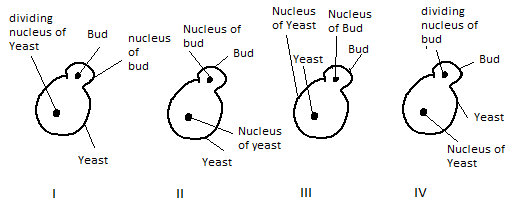
Answer
433.8k+ views
Hint: In an asymmetric separation mechanism called budding, most yeasts replicate asexually. Next, the parent cell develops a small protuberance that expands to a full size and forms a bud. The nucleus divides into a daughter nucleus of the parent cell and migrates to the daughter cell.
Complete answer:
Asexual reproduction mode of reproduction by budding, where the parent cell develops a small bud (also known as a bleb or daughter cell), is the most common mode of yeast vegetative growth. The nucleus splits into the parent cell's daughter nucleus and migrates to the daughter cell.
This differs but may be as short as one hour, with the pressure, the growth medium, and the temperature. At this point, in one day, a single cell will develop to become a barely visible colony. In yeast cultures, the growth activity is close to that of bacteria.
The essential characteristics of asexual reproduction include the following:
1)A single parent is involved.
2)No fertilization or development of the gamete takes place.
3)This replication process takes place during a relatively brief amount of time.
4)Organisms rapidly replicate and expand.
5)The offspring are genetically equivalent.
Hence, the correct answer is option (B)
Note: There are differences between budding in yeast and hydra:
1)Although hydra is a multicellular organism, yeast is a single-cell organism.
2)The bud originates in the yeast from a tiny protuberance on the parent body, while the bud occurs because of the repeated mitotic division in hydra.
3)The yeast gets its daughter nuclei and it may or may not differentiate from the parent body, while the daughter buds are multicellular in hydra and daughter buds do not grow.
Complete answer:
Asexual reproduction mode of reproduction by budding, where the parent cell develops a small bud (also known as a bleb or daughter cell), is the most common mode of yeast vegetative growth. The nucleus splits into the parent cell's daughter nucleus and migrates to the daughter cell.
This differs but may be as short as one hour, with the pressure, the growth medium, and the temperature. At this point, in one day, a single cell will develop to become a barely visible colony. In yeast cultures, the growth activity is close to that of bacteria.
The essential characteristics of asexual reproduction include the following:
1)A single parent is involved.
2)No fertilization or development of the gamete takes place.
3)This replication process takes place during a relatively brief amount of time.
4)Organisms rapidly replicate and expand.
5)The offspring are genetically equivalent.
Hence, the correct answer is option (B)
Note: There are differences between budding in yeast and hydra:
1)Although hydra is a multicellular organism, yeast is a single-cell organism.
2)The bud originates in the yeast from a tiny protuberance on the parent body, while the bud occurs because of the repeated mitotic division in hydra.
3)The yeast gets its daughter nuclei and it may or may not differentiate from the parent body, while the daughter buds are multicellular in hydra and daughter buds do not grow.
Recently Updated Pages
Fill in the blanks with suitable prepositions Break class 10 english CBSE

Fill in the blanks with suitable articles Tribune is class 10 english CBSE

Rearrange the following words and phrases to form a class 10 english CBSE

Select the opposite of the given word Permit aGive class 10 english CBSE

Fill in the blank with the most appropriate option class 10 english CBSE

Some places have oneline notices Which option is a class 10 english CBSE

Trending doubts
Fill the blanks with the suitable prepositions 1 The class 9 english CBSE

How do you graph the function fx 4x class 9 maths CBSE

When was Karauli Praja Mandal established 11934 21936 class 10 social science CBSE

Which are the Top 10 Largest Countries of the World?

What is the definite integral of zero a constant b class 12 maths CBSE

Why is steel more elastic than rubber class 11 physics CBSE

Distinguish between the following Ferrous and nonferrous class 9 social science CBSE

The Equation xxx + 2 is Satisfied when x is Equal to Class 10 Maths

Differentiate between homogeneous and heterogeneous class 12 chemistry CBSE





